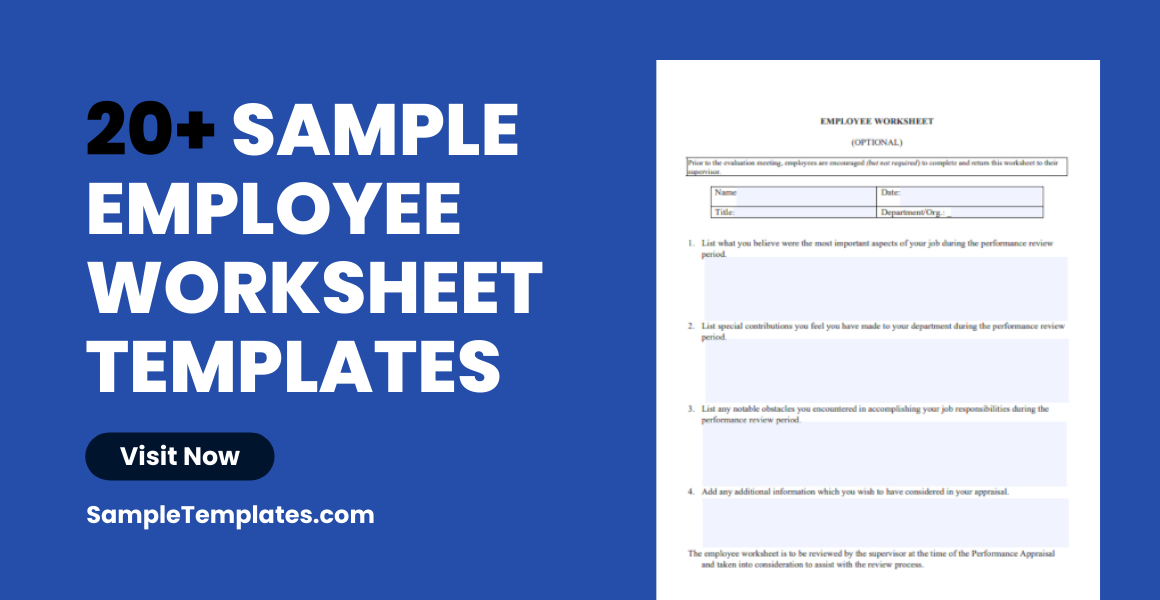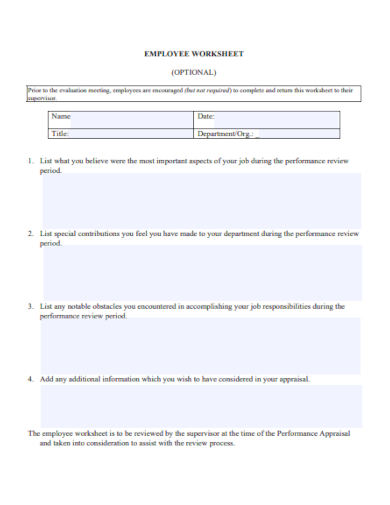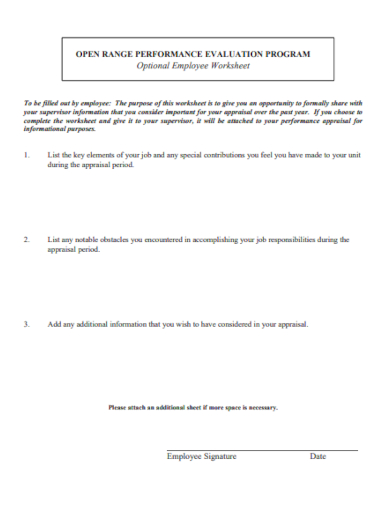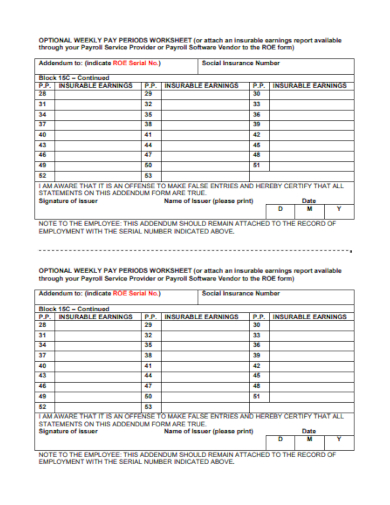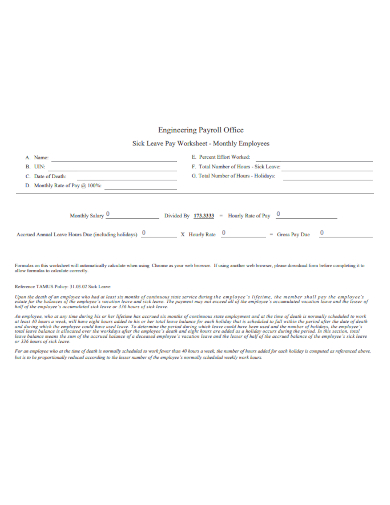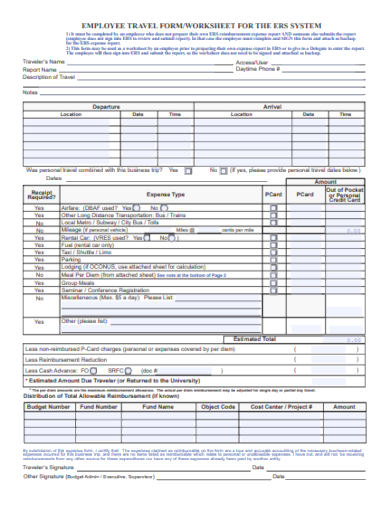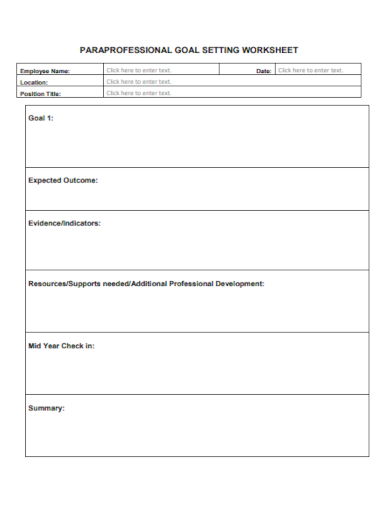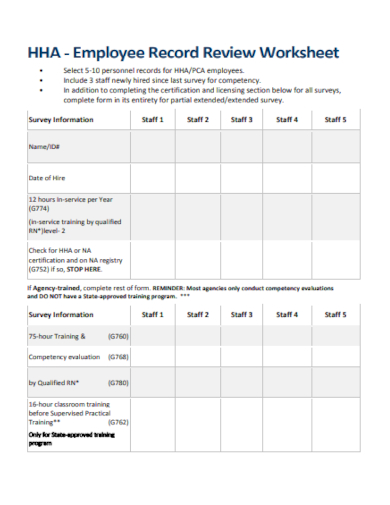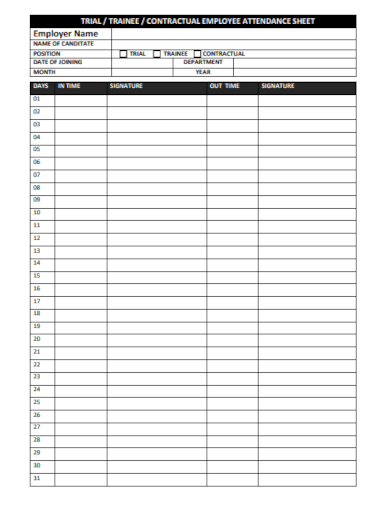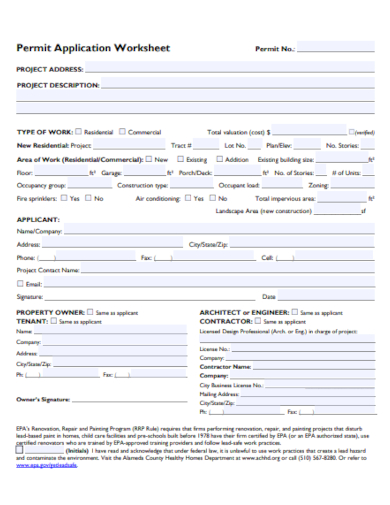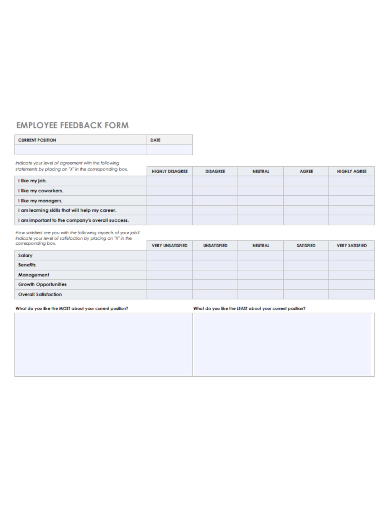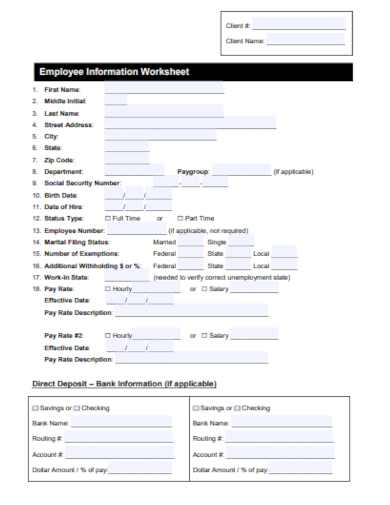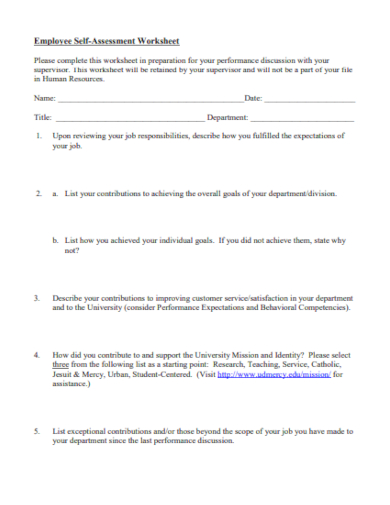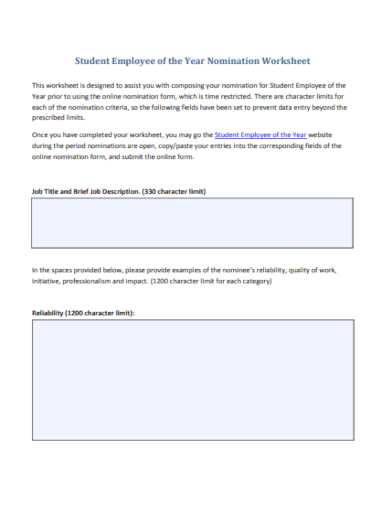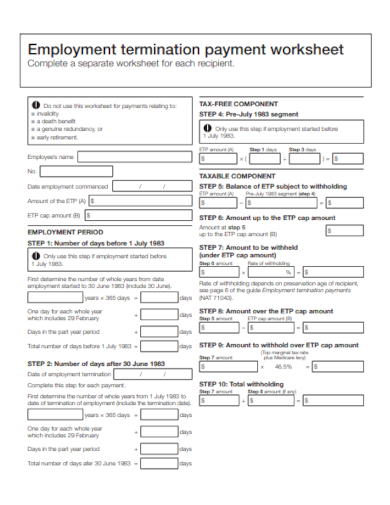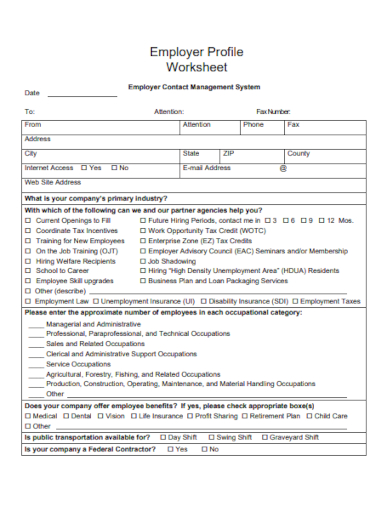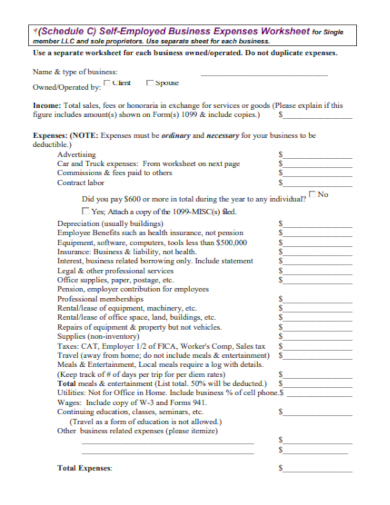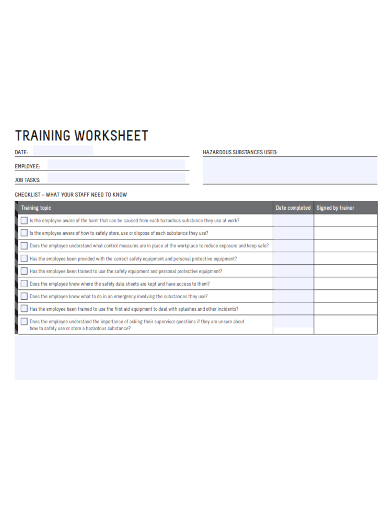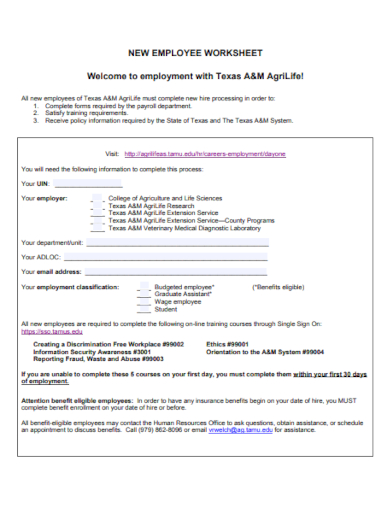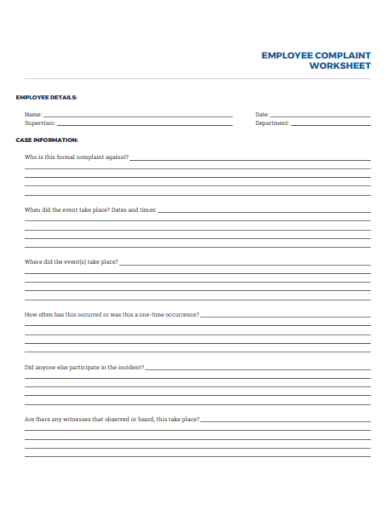Efficiency meets clarity with our Sample Employee Worksheet Template. Specifically crafted for HR professionals and team leaders, this template simplifies tracking, assessing, and elevating employee performance. Harness the power of structured data to optimize team output and foster continuous improvement. Equip yourself with this dynamic tool and transform how you approach employee management and development. Dive in today!
20+ Employee Worksheet Samples
1. Printable Employee Worksheet
2. Employee Worksheet Template
3. Weekly Employee Worksheet
4. Monthly Employee Worksheet
5. Employee Form Worksheet
6. Employee Goal Setting Worksheet
What is an Employee Worksheet?
An employee worksheet is a valuable tool in the realm of human resources, management, and organizational operations. At its core, it’s a document or digital interface designed to track, organize, and assess various aspects of an employee’s role, performance, and contributions within a company. Let’s delve deeper into its definition, components, and significance.
Purpose and Utility
The primary purpose of an employee worksheet is to provide a centralized location for storing and accessing pertinent information about an individual employee. This can range from basic details, like contact information and hire date, to more complex data, such as performance reviews, task assignments, and training records.
Managers and HR professionals utilize these worksheets to:
Monitor Performance: Regular updates about task completions, milestones achieved, and feedback can be recorded. This aids in assessing an employee’s strengths and areas that might need improvement.
Training and Development: By keeping a log of completed training sessions, managers can ensure that employees are up-to-date with the necessary skills and knowledge.
Attendance and Time Tracking: Many worksheets incorporate attendance records and time logs to help in payroll calculations and to track overall employee punctuality.
Goal Setting: Setting clear, measurable goals is pivotal for employee growth. A worksheet can delineate these objectives and track progress towards them.
Key Components
While the exact components of an employee worksheet can vary based on the needs of the company and its specific industry, several universal elements are commonly found:
Personal Details: This includes the employee’s full name, position, department, hire date, contact details, and emergency contact information.
Job Description: A brief overview of the employee’s primary responsibilities and tasks.
Performance Metrics: Quantitative and qualitative measurements that shed light on the employee’s efficacy, efficiency, and contributions.
Training and Certifications: A log of all training sessions attended, certifications earned, and their respective dates.
Attendance Record: A detailed log indicating days worked, absences, tardiness, and any other relevant time-related data.
Feedback and Reviews: Periodic assessments, peer reviews, and feedback from supervisors or team leads.
Significance in Modern Workplaces
In today’s fast-paced, data-driven corporate environment, the importance of organized, easily accessible information cannot be overstated. An employee worksheet offers several benefits:
Efficient Management: By having all the pertinent details about an employee in one place, managers can make informed decisions quickly.
Transparency: It ensures that employees know what’s expected of them, their current standing, and areas that need attention.
Consistency: Uniform templates mean every employee is assessed using the same criteria, ensuring fairness.
Facilitates Communication: Regular updates and feedback mechanisms can foster better communication between employees and supervisors.
An employee worksheet, be it in a traditional paper format or a modern digital interface, stands as a testament to the meticulousness with which companies approach employee management. It embodies a company’s commitment to fostering a structured, transparent, and growth-oriented environment. As workplaces continue to evolve, the tools and templates used might change, but the core idea of tracking and enhancing employee performance remains a constant.
7. Employee Personal Review Worksheet
8. Employee Attendance Worksheet
9. Employee Permit Application Worksheet
10. Employee Feedback Worksheet
11. Employee Information Worksheet
12. Employee Self-Assessment Worksheet
13. Student Employee Nomination Worksheet
What to Look for in an Employee Worksheet?
In the dynamic world of human resources and employee management, an employee worksheet serves as a cornerstone for effective and structured supervision. While the primary function of such worksheets is to consolidate and present pertinent details about an employee’s role and performance, the quality and depth of information can vary widely. So, how do you ensure you’re using a worksheet that genuinely adds value? Here’s what to look for:
Comprehensive Personal Details Section:
A well-structured employee worksheet starts with an in-depth section dedicated to the employee’s personal details. This should include not only basic information like name, position, and contact details but also emergency contacts, departmental affiliations, and direct supervisors.
Clear Job Description:
Every role has its unique requirements and responsibilities. A good worksheet will provide a clear and concise overview of the employee’s primary duties, allowing both the employee and the manager to have clear expectations from the outset.
Performance Metrics and Indicators:
One of the chief purposes of these worksheets is performance monitoring. The best ones incorporate both quantitative and qualitative metrics. This can range from completed projects, sales figures, and task completion rates to soft skills assessment, interpersonal dynamics, and initiative-taking.
Training and Development Records:
The modern workplace is an ever-evolving landscape, with continuous learning being a pivotal component. A quality worksheet should have sections dedicated to training sessions attended, skills acquired, certifications achieved, and upcoming training opportunities.
Goal Setting and Progress Tracking:
Goals drive performance. An excellent employee worksheet should not only allow for setting clear, measurable objectives but also facilitate the tracking of progress toward those goals over specified periods.
Attendance and Time Management:
Punctuality and time management are key performance indicators. A comprehensive worksheet will integrate a detailed attendance record, capturing days worked, holidays, sick leaves, and any overtime or special duty hours.
Feedback and Review Mechanism:
Continuous feedback is the bedrock of improvement. Ensure that the worksheet provides space for periodic reviews, be it monthly, quarterly, or annually. This includes both feedback from supervisors and, ideally, a section for peer or 360-degree reviews.
User-Friendliness:
No tool, no matter how comprehensive, is beneficial if it’s not user-friendly. Whether it’s a digital platform or a physical document, navigation should be intuitive, sections clearly labeled, and data input straightforward.
Flexibility and Customization:
Every organization and even departments within an organization can have varied needs. A top-tier worksheet will offer the flexibility to add, remove, or modify sections based on specific requirements.
Security Features (for digital formats):
If you’re using a digital worksheet, security is paramount. Ensure that the platform or software provides robust encryption and privacy controls to protect sensitive employee information.
A well-crafted employee worksheet is more than just a data repository; it’s a tool that facilitates better management, clearer communication, and continuous growth. By ensuring that the worksheet you use incorporates the features mentioned above, you’re taking a significant step toward optimizing employee performance and fostering a more structured, transparent, and growth-centric workplace environment.
14. Employee Termination Worksheet
15. Employee Planning Worksheet
16. Employee Observation Worksheet
17. Employee Profile Worksheet
18. Employee Business Expenses Worksheet
19. Employee Training Worksheet
20. New Employee Worksheet
21. Employee Complaint Worksheet
Tips for Using an Employee Worksheet
An employee worksheet, when utilized effectively, can be a pivotal tool in streamlining management processes, optimizing employee performance, and fostering growth. However, merely having a worksheet is not enough; its real value is derived from how it’s used. Here are some actionable tips to make the most of an employee worksheet:
Consistent Updates:
The dynamism of the workplace means that data can change rapidly. Ensure that the worksheet is updated consistently, whether it’s about project completions, training sessions attended, or performance metrics. Real-time or weekly updates can provide a more accurate picture of employee performance.
Collaborate with Employees:
Instead of solely being a management tool, turn the worksheet into a collaborative platform. Allow employees to update certain sections, set their own goals, and even provide their feedback. This fosters a sense of ownership and involvement.
Use as a Communication Tool:
During performance reviews or one-on-one sessions, use the worksheet as a point of reference. It provides tangible data points to discuss strengths, areas of improvement, and future plans, making the conversation more structured and productive.
Ensure Privacy:
Sensitive employee information, such as performance reviews or personal details, should be kept confidential. If using a digital platform, ensure robust security measures. For physical worksheets, store them in a secure location, accessible only to authorized personnel.
Customize to Suit Needs:
While standardized worksheets can be beneficial, every department or role might have specific requirements. Customize the worksheet based on the nuances of the position, incorporating unique metrics or sections relevant to the job.
Integrate with Other Tools:
If using digital worksheets, consider integrating them with other management tools or software. For instance, connecting the worksheet with attendance software can automate the tracking of leaves and punctuality.
Encourage Feedback:
The worksheet should be an evolving tool. Regularly solicit feedback from both managers and employees about its format, ease of use, and sections. This feedback can guide improvements and modifications.
Periodic Audits:
Every few months, review the worksheet for accuracy and relevance. Check for any discrepancies in the data and ensure that all sections are up to date. This ensures the tool remains reliable over time.
Use as a Training Aid:
For new managers or HR personnel, the worksheet can serve as a comprehensive overview of an employee’s journey in the organization. It can be used as a training aid to understand the employee’s strengths, past performance, and growth trajectory.
Visual Representation:
Data, when visualized, can be more impactful. Use graphs, sample charts, or infographics to represent performance metrics, training progression, or goal achievements. This not only makes the data more accessible but also facilitates better comprehension during reviews.
An employee worksheet, while simple in concept, holds the potential to revolutionize how management and employees interact, set goals, and track performance. By leveraging the tips mentioned above, companies can ensure they are extracting maximum value from this tool, leading to a more efficient, transparent, and growth-oriented organizational environment.
Related Posts
FREE 20+ Goal Setting Worksheet Samples in MS Word | Google Docs | Pages | Excel | Google Sheets | Numbers | PPT | PDF
FREE 30+ Cost Worksheet Samples in Google Docs | Google Sheets | MS Excel | MS Word | Apple Numbers | Apple Pages | PDF
FREE 50+ Assessment Worksheet Samples in PDF | MS Word
FREE 25+ Campaign Worksheet Samples in PDF
FREE 50+ Application Worksheet Samples in PDF | MS Word
FREE 10+ Distribution Worksheet Samples in PDF
FREE 10+ Family Worksheet Samples in PDF
FREE 10+ Personal Worksheet Samples in PDF
FREE 7+ Depreciation Worksheet Samples & Templates in PDF | MS Word
FREE 10+ Typing Worksheets Samples in PDF | DOC
FREE 10+ Maths Worksheets Samples in PDF | DOC
FREE 10+ 4th grade Worksheets Samples in PDF
FREE 10+ Weekly Budget Worksheet Samples in MS Word | MS Excel | Google Docs | Google Sheets | PDF
FREE 10+ Expense Worksheet Samples in PDF
FREE 10+ Investment Worksheet Samples in PDF
